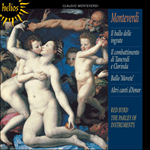
Welcome to Hyperion Records, an independent British classical label devoted to presenting high-quality recordings of music of all styles and from all periods from the twelfth century to the twenty-first.
Hyperion offers both CDs, and downloads in a number of formats. The site is also available in several languages.
Please use the dropdown buttons to set your preferred options, or use the checkbox to accept the defaults.

| Red Byrd, The Parley of Instruments» More |
 PERFORMANCE
PERFORMANCE RECORDING
RECORDINGThe ballet begins with an instrumental entrata for the dancers, and the Poet sings a prologue, punctuated by the music of the entrata, in which he envisages an age of peace under Ferdinand’s rule. Taking a lyre, he addresses Ferdinand, and then invites the ladies to dance and the nymphs of the Danube (Istro) to join them. They dance first to a chorus, ‘Movete al mio bel suon’, and then to ‘any other dance without song’ (Monteverdi does not supply this) before the second part of ‘Movete al mio bel suon’. Although Monteverdi’s ballet is itself brief, it was probably intended to be performed in the midst of other music, and may have been followed by social dancing.
from notes by John Whenham © 2014
Le ballet s’ouvre sur une entrata instrumentale destinée aux danseurs, et le Poète chante un prologue, ponctué par la musique de l’entrata, où il envisage une ère de paix sous le règne de Ferdinand. Prenant un luth, il s’adresse au souverain avant d’inviter les dames à danser et les nymphes du Danube (Istro) à les rejoindre. Elles dansent sur un chœur, «Movete al mio bel suon», puis sur «une autre danse sans paroles» (que Monteverdi ne fournit pas) avant la seconde partie de «Movete al mio bel suon». Malgré sa brièveté, le ballet de Monteverdi devait probablement être joué au milieu d’une autre musique et était peut-être suivi d’une danse mondaine.
extrait des notes rédigées par John Whenham © 2014
Français: Hypérion
Das Ballett beginnt mit einer instrumentalen Entrata für die Tänzer und der Dichter singt dazu einen Prolog, in dem er ein Zeitalter des Friedens unter der Herrschaft Ferdinands voraussieht. Er nimmt eine Laute und wendet sich an Ferdinand; dann fordert er die Damen zum Tanzen auf und die Nymphen der Donau (Istro) sich dazuzugesellen. Zuerst tanzen sie zu einem Chor, „Movete al mio bel suon“, und dann zu einem „beliebigen anderen Tanz ohne Lied“ (den Monteverdi nicht angibt), bevor der zweite Teil von „Movete al mio bel suon“ erklingt. Obwohl Monteverdis Ballett selbst kurz gehalten ist, war es wahrscheinlich als Beigabe zu anderer Musik gedacht, und es ist gut möglich, dass darauf ein Gesellschaftstanz folgte.
aus dem Begleittext von John Whenham © 2014
Deutsch: Viola Scheffel
 Monteverdi: Il ballo delle ingrate & other works Monteverdi: Il ballo delle ingrate & other works‘At the pinnacle of current Monteverdi singing on records’ (Fanfare, USA) ‘One of the most perfect CDs ever made. Unsurpassable: glorious music, superb performances and hair-raising sound. The performers, engineers, and Hype ...» More |

